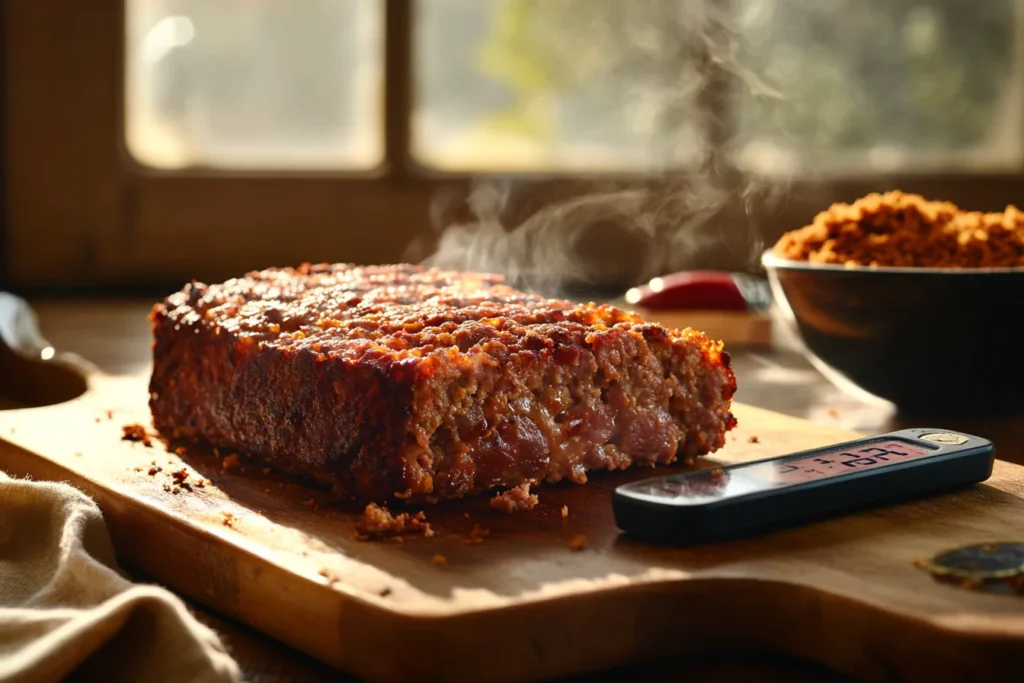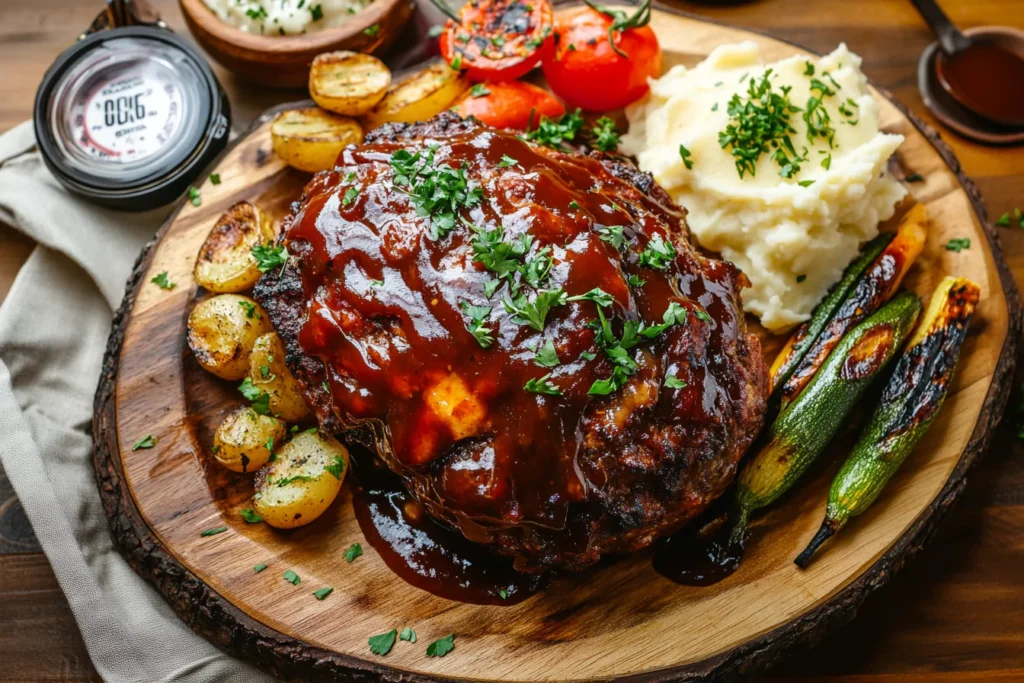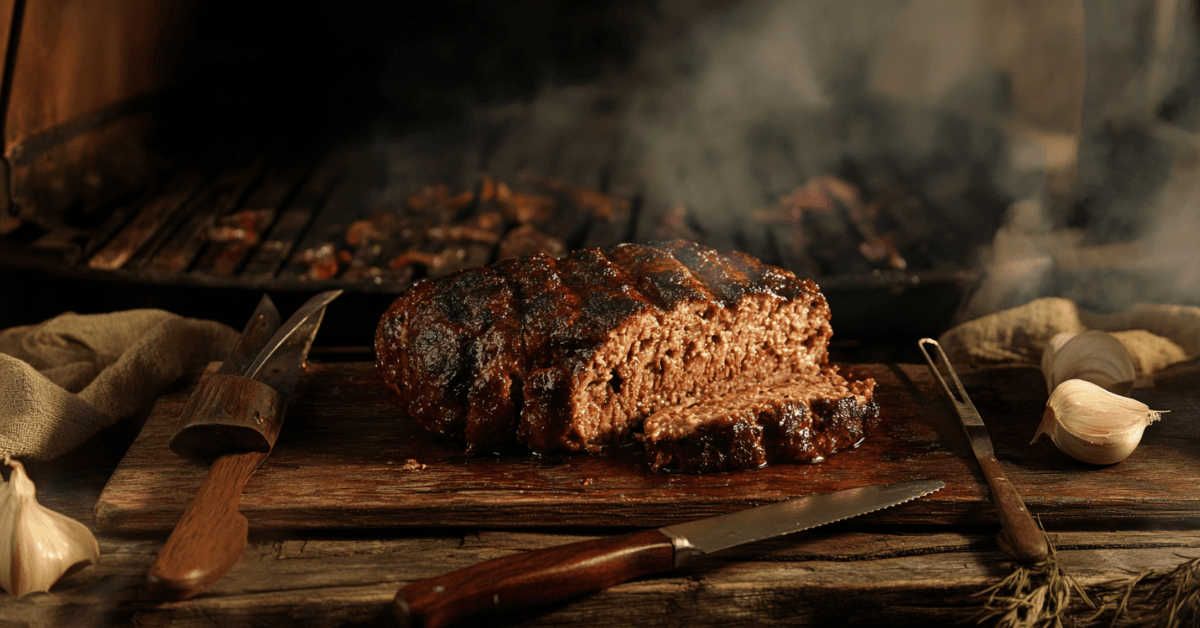Smoking meatloaf is a delicious way to elevate this comfort food, but many pitmasters wonder, does smoked meatloaf stall like brisket ? The stall, a temperature plateau during smoking, can impact cooking time and results. This article explores whether smoked meatloaf stalls, why it happens, and how to handle it for the perfect smoky flavor.
Smoking meatloaf is a delicious way to elevate this comfort food, but many pitmasters wonder, does smoked meatloaf stall like brisket ? The stall, a temperature plateau during smoking, can impact cooking time and results. This article explores whether smoked meatloaf stalls, why it happens, and how to handle it for the perfect smoky flavor. For a step-by-step guide to making moist and flavorful smoked meatloaf, check out this easy smoked meatloaf recipe.
Understanding the Stall: Does Smoked Meatloaf Stall?
Smoking meats often involves a curious phenomenon known as “the stall,” where the internal temperature of the meat plateaus for an extended period, leaving many cooks frustrated and scratching their heads. To understand whether smoked meatloaf stalls, it’s crucial to first grasp the mechanics of this process.

What Is the Stall?
The stall occurs when the internal temperature of the meat hits a plateau, often between 150°F and 170°F (65°C to 75°C), and refuses to rise for a prolonged time. This is most commonly experienced when smoking large cuts of meat such as brisket, pork butt, or ribs. The process can take hours to resolve and is caused by a combination of factors:
- Evaporative Cooling: As the meat’s surface releases moisture during the cooking process, it cools the meat, counteracting the heat from the smoker. This evaporation creates a cooling effect similar to how sweat cools the human body.
- Temperature Dynamics: The balance between heat entering the smoker and the cooling effect from evaporation creates the temperature plateau.
Does Every Meat Stall?
The stall is not exclusive to all meats. Certain factors, such as the type of meat, thickness, fat content, and preparation, can influence whether the stall happens and how pronounced it will be. Cuts with a large surface area and significant moisture content are more likely to stall than smaller or leaner cuts.
Science Behind the Stall
At its core, the stall is a scientific process involving thermodynamics. As the smoker’s heat causes the meat’s internal moisture to evaporate, the cooling effect delays further temperature rise. Once the surface moisture evaporates completely, the meat resumes cooking and its temperature climbs steadily.
In smoking practices, it is a normal part of low-and-slow cooking. But does it apply to smoked meatloaf? Let’s explore further.
Does Smoked Meatloaf Stall During Smoking?
Smoked meatloaf is a unique contender when it comes to the stall because it differs significantly from traditional cuts like brisket.
Does Smoking Meatloaf Stall Like Larger Cuts of Meat?
Meatloaf is typically made with a blend of ground meats, such as beef, pork, or a combination. Unlike large, dense cuts of meat, its structure is less compact, and the uniform consistency means heat penetrates more evenly. These factors reduce the likelihood and duration of a stall. However, the stall can still occur under certain conditions, such as when the meatloaf is very thick or the smoker’s temperature is particularly low.
Observations From Pitmasters
Experienced pitmasters report mixed results when smoking meatloaf. Some claim their meatloaf experienced a brief stall, particularly when smoked at low temperatures like 225°F (107°C). Others find that the ground meat mixture, due to its finer texture and fat distribution, cooks more steadily, bypassing the lengthy stall seen in brisket or pork butt.
Key Factors Influencing the Smoked Meatloaf Stall
- Thickness: A thicker meatloaf takes longer for heat to penetrate, increasing the chances of a stall.
- Moisture Content: Higher moisture levels in the meat mixture or added ingredients (e.g., vegetables or breadcrumbs) can lead to more evaporation, causing a cooling effect.
- Smoker Conditions: A smoker with poor air circulation or insufficient heat can amplify the cooling effect, making a stall more likely.
Factors That Affect the Stall
Several variables influence whether or not smoked meatloaf experiences a stall. From the ingredients in the meatloaf to the conditions inside your smoker, these factors can determine if you encounter a temperature plateau and how to address it.
Type of Meat Used in Meatloaf
The type of meat used in your meatloaf plays a critical role in whether it stalls. Traditional meatloaf recipes often combine beef, pork, and sometimes veal, each of which has different moisture and fat content.
- Fat Content: Meats with higher fat content, like ground pork or beef with an 80/20 ratio, tend to retain moisture, which can lead to more evaporation and a possible stall.
- Lean Meat: Leaner meats, such as ground turkey or chicken, are less likely to stall due to lower moisture levels, but they can dry out quickly if overcooked.
Thickness and Size of the Meatloaf
The physical size of your meatloaf significantly impacts the cooking process. A thick, dense meatloaf takes longer for heat to penetrate, increasing the potential for a stall.
- Thin Meatloaf: A thinner or loaf-shaped meatloaf may cook more quickly and evenly, avoiding the stall altogether.
- Large Meatloaf: A large, thick meatloaf has more surface area for moisture to evaporate, which can prolong the cooking process and cause a stall.
Temperature and Humidity in the Smoker
The internal conditions of your smoker also play a major role in determining whether a stall will occur.
- Low Smoking Temperatures: Smoking at 225°F (107°C) can make the meatloaf more prone to stalling due to the slower cooking process.
- Humidity Levels: High humidity inside the smoker can reduce evaporation, helping to minimize the stall. Conversely, low humidity promotes evaporation, increasing the likelihood of a stall.
Type of Smoker and Fuel
The type of smoker you use and the fuel it burns can affect the cooking environment, influencing whether your meatloaf stalls:
- Offset Smokers: These can produce consistent heat but may have uneven airflow, contributing to slower cooking in certain areas of the meatloaf.
- Electric Smokers: Known for precise temperature control, these may reduce the risk of a stall.
- Fuel Type: Wood and charcoal can produce varying heat and smoke levels compared to pellet smokers, which typically maintain more consistent conditions.
Additional Ingredients in the Meatloaf
The components of your meatloaf recipe can also impact the likelihood of a stall.
- Breadcrumbs or Fillers: These absorb moisture and can slow evaporation, potentially minimizing a stall.
- Vegetables: Ingredients like onions, peppers, or grated carrots add moisture to the mix, increasing evaporation during smoking.
- Glazes or Sauces: Applying a glaze or sauce early in the smoking process can lock in surface moisture, reducing evaporation and possibly preventing the stall.
How to Handle a Stall When Smoking Meatloaf
If your smoked meatloaf encounters a stall, don’t worry! Stalls are a natural part of the smoking process and can be managed effectively. Here are proven techniques to handle a stall while ensuring your meatloaf turns out perfectly cooked, moist, and flavorful.
Does Wrapping Smoked Meatloaf Help Overcome the Stall?
One of the most popular methods to overcome a stall is wrapping the meatloaf in aluminum foil or butcher paper, commonly known as the “Texas Crutch.”
- How It Works: Wrapping reduces evaporation by creating a barrier that traps moisture and heat around the meatloaf. This prevents further cooling and allows the internal temperature to rise steadily.
- When to Wrap: Wrap the meatloaf when its internal temperature reaches 150°F to 160°F (65°C to 71°C).
- Steps to Wrap:
- Remove the meatloaf from the smoker temporarily.
- Wrap it tightly in foil or butcher paper, ensuring no gaps for steam to escape.
- Return it to the smoker to finish cooking.
Adjusting the Smoker Temperature
Raising the smoker’s temperature slightly can help push through the stall.
- Increase Heat Gradually: If your smoker is set at 225°F (107°C), consider increasing it to 250°F (121°C) or even 275°F (135°C) during the stall.
- Monitor Closely: Higher temperatures can speed up cooking but may risk overcooking or drying out the meatloaf, so use a meat thermometer to track progress.
Maintaining Patience and Timing
Sometimes the best way to handle a stall is simply to wait it out. Smoking meatloaf, like any other smoked dish, requires patience to achieve the desired results.
- Avoid Opening the Smoker Lid: Each time you open the lid, heat escapes, prolonging the stall and the overall cooking time.
- Plan for the Stall: Build extra time into your cooking schedule, especially for larger or thicker meatloaves.
Using a Water Pan for Moisture Control
Placing a water pan inside your smoker can help regulate humidity, reducing evaporation and minimizing the chances of a stall.
- How It Works: The water adds moisture to the smoker’s environment, decreasing the rate of surface evaporation.
- Placement Tips: Position the water pan directly under or near the meatloaf to maintain consistent humidity levels.
Monitoring Internal Temperature
Using a reliable meat thermometer is essential for managing a stall.
- Track Progress: Insert a meat probe into the center of the meatloaf to monitor its internal temperature without opening the smoker.
- Target Temperature: Meatloaf is safe to eat when its internal temperature reaches 165°F (74°C), but some pitmasters prefer to cook it slightly higher for enhanced flavor and texture.
Avoiding Over-Smoking While Managing the Meatloaf Stall
While waiting out the stall, it’s easy to over-smoke the meatloaf, leading to overly intense flavors or bitterness.
- Wood Choice Matters: Use mild woods like apple, cherry, or pecan to avoid overpowering the meatloaf’s flavor.
- Time It Right: Avoid adding wood chips or chunks too late in the process, as meat absorbs the most smoke flavor during the early stages of cooking.
Embracing the Stall
The stall might feel frustrating, but it’s an integral part of the smoking process. By understanding it and applying the right techniques, you can turn it into an opportunity to enhance the final product.
Tips for Smoking Perfect Meatloaf: Avoiding the Stall
Smoking meatloaf is a rewarding culinary experience, blending the comfort of a classic dish with the bold flavors of smoked barbecue. Achieving perfection requires a balance of preparation, technique, and attention to detail. Here are essential tips to make your smoked meatloaf outstanding every time.

Choose the Right Meat Blend
The foundation of great smoked meatloaf starts with selecting the right combination of ground meats.
- Fat-to-Lean Ratio: Aim for a blend with an 80/20 fat-to-lean ratio for rich flavor and moisture retention.
- Mixing Options: Combine ground beef with ground pork or veal for a flavorful and tender texture. Ground turkey or chicken can be used for leaner alternatives but may require additional fat or binders.
Prepare the Perfect Meatloaf Mixture
The ingredients you mix into the meatloaf can make or break the final product.
- Binders: Use eggs, breadcrumbs, or crushed crackers to bind the ingredients and prevent crumbling during smoking.
- Moisture Boosters: Add sautéed onions, shredded vegetables, or milk-soaked bread for added moisture and flavor.
- Seasoning: Don’t skimp on seasoning—use a balanced blend of salt, pepper, garlic powder, smoked paprika, and herbs.
Shape the Meatloaf for Smoking
The shape and size of the meatloaf influence cooking time and evenness.
- Loaf Shape: Form the meatloaf into a uniform loaf, ensuring it’s not too thick to allow heat to penetrate evenly.
- Avoid Overpacking: Handle the mixture gently when shaping to avoid a dense, tough texture.
Use the Right Wood for Smoking
The choice of wood directly affects the flavor profile of your smoked meatloaf.
- Mild Woods: Apple, cherry, and pecan woods are excellent for imparting a sweet and subtle smoky flavor.
- Strong Woods: Hickory or mesquite can add a bold, intense flavor but should be used sparingly to avoid overpowering the meatloaf.
Glazing for Extra Flavor
A glaze can elevate your smoked meatloaf with a glossy finish and a burst of flavor.
- Classic Tomato Glaze: Combine ketchup, brown sugar, and a splash of Worcestershire sauce for a sweet and tangy topping.
- BBQ Glaze: Use your favorite barbecue sauce for a smoky, savory kick. Apply during the last 15-20 minutes of cooking to avoid burning.
Smoking Temperature and Time
Understanding the correct smoking temperature and cooking time is key to perfectly cooked meatloaf.
- Ideal Smoking Temperature: Maintain the smoker at 225°F to 250°F (107°C to 121°C) for a slow and steady cook.
- Cooking Time: Expect 1.5 to 2 hours of smoking for an average-sized meatloaf (2 pounds), depending on its thickness.
- Monitor Internal Temperature: Use a meat thermometer to ensure the internal temperature reaches at least 165°F (74°C) for food safety.
Resting the Meatloaf
Resting the meatloaf after smoking allows the juices to redistribute, enhancing flavor and texture.
- Duration: Let the meatloaf rest for 10-15 minutes after removing it from the smoker.
- Tent with Foil: Cover the meatloaf loosely with foil during the resting period to retain heat without making it soggy.
Serving Suggestions
Pair your smoked meatloaf with complementary sides and sauces for a complete meal.
- Side Dishes: Mashed potatoes, roasted vegetables, or macaroni and cheese are classic pairings.
- Sauce Options: Serve extra glaze or barbecue sauce on the side for those who enjoy a saucier bite.
FAQs
Smoking meatloaf is an intriguing and rewarding cooking process, but it often raises questions for beginners and experienced pitmasters alike. Here are some frequently asked questions about smoked meatloaf and the stall phenomenon.
Does smoked meatloaf always stall?
No, smoked meatloaf does not always experience a stall. Factors like its smaller size, lower density compared to large cuts of meat, and the ground meat mixture often prevent a significant stall. However, thick meatloaves or low smoker temperatures may occasionally result in a brief stall.
What’s the best way to monitor the temperature of smoked meatloaf?
Using a meat thermometer is essential for accuracy. Insert the probe into the center of the meatloaf to monitor its internal temperature. Many smokers come with built-in thermometers, but a handheld digital meat thermometer offers better precision.
Can I use store-bought meatloaf for smoking?
Yes, you can smoke store-bought meatloaf, but ensure it is uncooked and not pre-baked. Adding your seasoning or glaze can enhance its flavor. Always check the internal temperature to ensure it reaches 165°F (74°C) for food safety.
How can I avoid over-smoking my meatloaf?
To avoid over-smoking:
- Use mild wood chips like apple or cherry for a subtle flavor.
- Limit the smoking time to no more than 2 hours, especially for smaller meatloaves.
- Avoid adding wood chips too late in the smoking process, as meat absorbs the most smoke flavor in the early stages.
Should I wrap smoked meatloaf in foil?
Wrapping in foil (the Texas Crutch) can help speed up cooking and prevent a stall by trapping heat and moisture. It’s particularly useful if you’re smoking in a low-temperature environment or cooking a thick meatloaf. Unwrap it during the final 20 minutes to let the exterior develop a nice crust.
Can I freeze smoked meatloaf leftovers?
Yes, smoked meatloaf freezes well. Allow it to cool completely, then wrap it tightly in plastic wrap and aluminum foil, or store it in an airtight container. It can be frozen for up to 3 months. Reheat in the oven for the best results.
Conclusion
By choosing the right meat blend, managing temperature, and employing techniques like wrapping and glazing, you can consistently create a moist, tender, and delicious smoked meatloaf. For instance, using milk instead of water in your meatloaf mixture not only enhances moisture but also helps bind the ingredients together, ensuring a perfect texture. (Learn more about why milk is used in meatloaf here.)
Additionally, incorporating ingredients like eggs and breadcrumbs is essential to prevent your meatloaf from falling apart. (Discover what ingredient keeps meatloaf from falling apart here.) For more tips on achieving a juicy and flavorful dish, check out our guide on the secret to moist meatloaf.
Whether you’re a seasoned pitmaster or a beginner exploring smoking for the first time, smoked meatloaf is a dish that’s sure to impress. With the right techniques and a little practice, you’ll master this delicious twist on a classic favorite.

